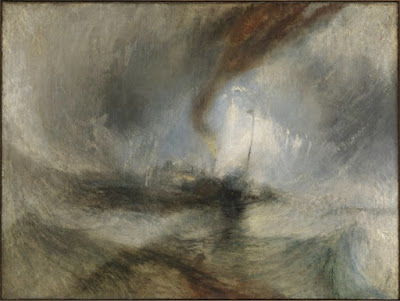I went to an amazing class this past Sunday, about the artist J. M. W. Turner. He's been one of my favourite painters for as long as I can remember. I love his seascapes in particular.
Dutch Boats in a Gale (1801)
But this class really opened my eyes as to why I like him so much. The teacher, Marcia Rackow, is an artist herself, and has studied Aesthetic Realism's explanation of beauty and its meaning for our lives for well over forty years. Her critiques of works of art are groundbreaking. She studied with Eli Siegel, the founder of Aesthetic Realism, and I'm so proud that she's a colleague of mine in classes taught now by the Chairman of Education, Ellen Reiss, for people teaching and learning to teach Aesthetic Realism.
In Sunday's class in the course The Visual Arts and the Opposites, Ms. Rackow took up works on exhibition at the Kimbell Art Museum's exhibition, "Turner's Modern World," originally at the Tate Britain. The basis of the class is this principle by Eli Siegel: "All beauty is a making one of opposites, and the making one of opposites is what we are going after in ourselves." Marcia Rackow began by describing briefly some aspects of Turner's life, and his passion for painting. The quotations are from my notes and not be word for word.
She said "What he most wanted to paint was light; its motion, its beauty, its wonder." And the class sure demonstrated the results of that admirable purpose. She quoted artist and critic Dorothy Koppelman, founder of the Terrain Gallery in New York City:
Magnificently, in the paintings of Joseph Mallord William Turner, there is a light so blazing and so deep, one can almost be completely absorbed—and always, too, there is that blackness.
This had me see Turner's work more deeply, and we saw throughout the class that in every painting, Turner had touches of dark where there was brilliance; and in areas of light there was mystery, depth, often blackness. For instance, in The Great Western Railway of 1844 (see below) she pointed out how that dark train emerges from the lighter background; and how there's a light form rising into the sky behind and to the left of the locomotive that is related to the form of the train with its dark rising form.
Rain, Steam and Speed - The Great Western Railway (1844)
Through studying Turner's work, Ms. Rackow said, "we can learn how to do a better job with light and dark in our own lives." That is what happened to me over the course of the 90 minutes. Through seeing the dark and light composed, dealt with so deftly and with such passion, I felt that what is known and unknown in myself were more friendly to each other, and that my desire to be hidden but also out in the sunlight were better composed and also really interesting.
A statement I love is the following: "There was a drama of light and dark so deeply in Turner, he had to present them in stark opposition and also so lovingly of each other." Commenting on a question by a student in the class, Ms. Rackow said that Turner traveled all over, was outdoors, and studying painting and drawing his whole life: "He wanted to see. He was looking all the time,"
Something that struck me keenly was what she said about the anger with which Turner's groundbreaking paintings were met. One critic described a work as "soapsuds and whitewash." There was anger at a new sight of the world, something unexpected that evoked great respect and wonder. This must have hurt Turner so much. I agree with Marcia Rackow that this is related to the vicious attacks there have been on Eli Siegel and Aesthetic Realism, and for the same reason: there is new, large, unexpected respect for people and reality. But now it's Turner's paintings that people all over the world flock to see. And this class explained why. Aesthetic Realism, which takes in study of all the arts and sciences, all the culture and history of the world, from Shakespeare to Rembrandt to Beethoven, from the caves of Lascaux to the events of the American Civil War, is being called a cult by a few people who want to scare others away from studying it. Well James Mallord William Turner RA was lied about at one time! Perspective is invaluable. Here are two more of the paintings Marcia Rackow took up. In each, one could study for hours the interrelation of dark and light, which as she explained was come to with great technical skill as well as passion. I highly recommend the class, which is currently being given via Zoom, to anyone interested in the visual arts:
Snow Storm: Steam Boat off a Harbour's Mouth (1842)
The Burning of the Houses of Lords and Commons (1835)





